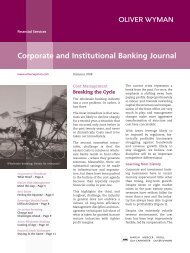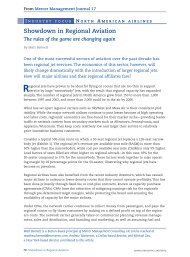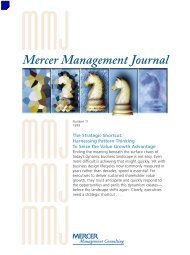Download the Report - Oliver Wyman
Download the Report - Oliver Wyman
Download the Report - Oliver Wyman
Create successful ePaper yourself
Turn your PDF publications into a flip-book with our unique Google optimized e-Paper software.
itself to a highly structured process with strict<br />
priorities, deadlines, and resource allocations.<br />
Businesses operating in emerging markets, on <strong>the</strong><br />
o<strong>the</strong>r hand, face <strong>the</strong> dual imperatives of speed<br />
and flexibility, which calls for R&D processes that<br />
can respond swiftly to unexpected demands and<br />
opportunities.<br />
Consequently, <strong>the</strong> strategic enterprise demands<br />
research processes that can maximize <strong>the</strong> value of<br />
pooled innovation while promoting distinctly different<br />
“innovation streams,” or processes for turning<br />
research into marketable products and services.<br />
R&D should not be placed in a straitjacket<br />
of uniform patterns throughout <strong>the</strong> enterprise.<br />
Designing for process management<br />
In contrast with <strong>the</strong> conglomerates and holding<br />
companies of <strong>the</strong> past, <strong>the</strong> strategic enterprise<br />
creates value by leveraging shared processes,<br />
capabilities, and competencies. At <strong>the</strong> very least,<br />
<strong>the</strong> enterprise creates economies of scale through<br />
common management of businesses that are<br />
strategically linked by business design. Beyond<br />
that, by developing superior process management<br />
skills and applying <strong>the</strong>m, where appropriate, to<br />
each of its business units, <strong>the</strong> enterprise drives<br />
performance at each unit to higher levels than<br />
any of <strong>the</strong>m could have enjoyed under separate<br />
ownership and management.<br />
Consider The Limited Inc., a collection of retail<br />
businesses selling products ranging from casual<br />
clothing (The Limited, Express, Structure) to intimate<br />
wear (Victoria's Secret) to personal care<br />
products (Bath & Body Works). The Limited engineered<br />
a significant turnaround in <strong>the</strong> late 1990s<br />
by creating an activist corporate center. On one<br />
hand, <strong>the</strong> company sought efficiencies by leveraging<br />
its businesses' shared capabilities in areas such<br />
as logistics, real estate management, and information<br />
technology. The Limited went beyond that,<br />
however, centralizing certain value-creating functions,<br />
such as product design, that were crucial to<br />
its strategy for growing <strong>the</strong> brands.<br />
Leaders intent on leveraging <strong>the</strong> middle should<br />
start by selecting <strong>the</strong> appropriate role for <strong>the</strong>ir<br />
corporate center. The next step is to identify those<br />
activities and processes that hold <strong>the</strong> greatest<br />
potential for leverage. At that point, <strong>the</strong> critical<br />
design concept is “asymmetric application.” In<br />
o<strong>the</strong>r words, <strong>the</strong> corporate center might play a<br />
dominant role in managing certain functions or<br />
processes at some business units but not at o<strong>the</strong>rs.<br />
The enterprise's traditional business units likely<br />
should be operated with an eye toward maximizing<br />
assets to provide predictable growth while<br />
avoiding major risk. On <strong>the</strong> o<strong>the</strong>r hand, <strong>the</strong><br />
start-up businesses involve minimal assets, big<br />
bets, high risks, and an explicit willingness to<br />
walk away from unsuccessful ventures—a business<br />
model involving dramatically different budget<br />
cycles, staffing requirements, and technology<br />
demands.<br />
Managing <strong>the</strong> dynamic balance<br />
To build a successful strategic enterprise, senior<br />
managers will have to educate <strong>the</strong>ir staff about<br />
what this looks like, why it's necessary, and how it<br />
will affect <strong>the</strong>m.<br />
Staff must understand <strong>the</strong> concept of asymmetry<br />
and why <strong>the</strong> idea that “everybody should play by<br />
<strong>the</strong> same rules” is a blueprint for disaster.<br />
As quickly as possible, leaders should clarify specific<br />
roles and rules of engagement. It's also important<br />
at <strong>the</strong> outset to promote explicit processes<br />
for managing conflict, which will appear early<br />
and often. Inevitably, <strong>the</strong>re will be intense disputes<br />
between businesses employing different distribution<br />
channels to reach <strong>the</strong> same customers;<br />
between businesses making competing demands<br />
upon <strong>the</strong> limited research and development<br />
resources; and between <strong>the</strong> conflicting values<br />
and priorities of traditional businesses and <strong>the</strong>ir<br />
start-up partners. Unless senior leaders spell out<br />
a process for dealing with conflicts in a swift,<br />
constructive way, those conflicts will paralyze <strong>the</strong><br />
enterprise. Successful leaders, often schooled in<br />
building consensus, will have to recognize that<br />
<strong>the</strong>ir real goal is cohesion, not harmony.<br />
The complex balancing act implicit in <strong>the</strong> design<br />
of <strong>the</strong> strategic enterprise will place unprecedented<br />
demands on leaders at both <strong>the</strong> enterprise and<br />
operating unit levels of <strong>the</strong> organization. For<br />
many individuals, <strong>the</strong>se changes will be difficult,<br />
perhaps even impossible, but for complex organizations,<br />
<strong>the</strong>y will be essential.c<br />
David A. Nadler is chairman and Mark B. Nadler is<br />
head of <strong>the</strong> Enterprise Communications Group of<br />
Mercer Delta, a New York-based sister firm of<br />
Mercer Management Consulting.<br />
14 Portfolio redesign Mercer Management Journal
















